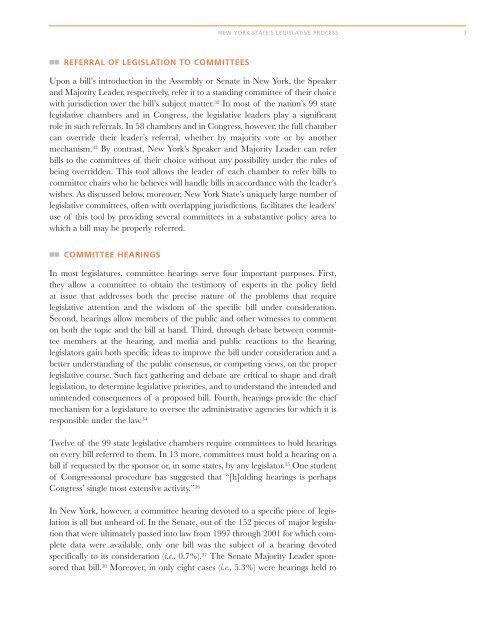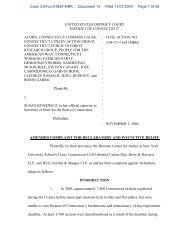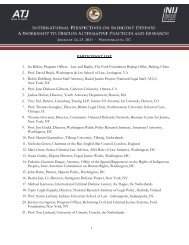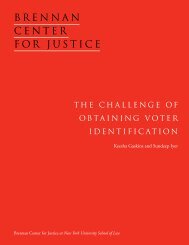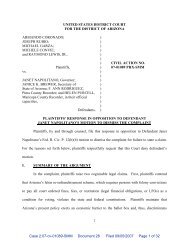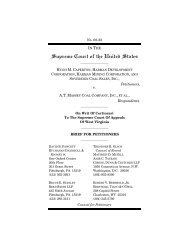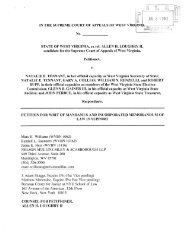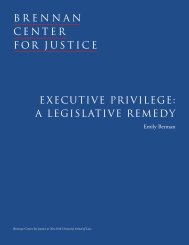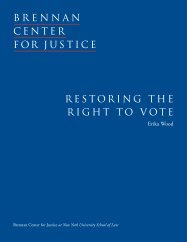THE NEW YORK STATE LEGISLATIVE PROCESS: AN ...
THE NEW YORK STATE LEGISLATIVE PROCESS: AN ...
THE NEW YORK STATE LEGISLATIVE PROCESS: AN ...
You also want an ePaper? Increase the reach of your titles
YUMPU automatically turns print PDFs into web optimized ePapers that Google loves.
■■ REFERRAL OF LEGISLATION TO COMMITTEES<br />
Upon a bill’s introduction in the Assembly or Senate in New York, the Speaker<br />
and Majority Leader, respectively, refer it to a standing committee of their choice<br />
with jurisdiction over the bill’s subject matter. 32 In most of the nation’s 99 state<br />
legislative chambers and in Congress, the legislative leaders play a significant<br />
role in such referrals. In 58 chambers and in Congress, however, the full chamber<br />
can override their leader’s referral, whether by majority vote or by another<br />
mechanism. 33 By contrast, New York’s Speaker and Majority Leader can refer<br />
bills to the committees of their choice without any possibility under the rules of<br />
being overridden. This tool allows the leader of each chamber to refer bills to<br />
committee chairs who he believes will handle bills in accordance with the leader’s<br />
wishes. As discussed below, moreover, New York State’s uniquely large number of<br />
legislative committees, often with overlapping jurisdictions, facilitates the leaders’<br />
use of this tool by providing several committees in a substantive policy area to<br />
which a bill may be properly referred.<br />
■■ COMMITTEE HEARINGS<br />
In most legislatures, committee hearings serve four important purposes. First,<br />
they allow a committee to obtain the testimony of experts in the policy field<br />
at issue that addresses both the precise nature of the problems that require<br />
legislative attention and the wisdom of the specific bill under consideration.<br />
Second, hearings allow members of the public and other witnesses to comment<br />
on both the topic and the bill at hand. Third, through debate between committee<br />
members at the hearing, and media and public reactions to the hearing,<br />
legislators gain both specific ideas to improve the bill under consideration and a<br />
better understanding of the public consensus, or competing views, on the proper<br />
legislative course. Such fact gathering and debate are critical to shape and draft<br />
legislation, to determine legislative priorities, and to understand the intended and<br />
unintended consequences of a proposed bill. Fourth, hearings provide the chief<br />
mechanism for a legislature to oversee the administrative agencies for which it is<br />
responsible under the law. 34<br />
Twelve of the 99 state legislative chambers require committees to hold hearings<br />
on every bill referred to them. In 13 more, committees must hold a hearing on a<br />
bill if requested by the sponsor or, in some states, by any legislator. 35 One student<br />
of Congressional procedure has suggested that “[h]olding hearings is perhaps<br />
Congress’ single most extensive activity.” 36<br />
In New York, however, a committee hearing devoted to a specific piece of legislation<br />
is all but unheard of. In the Senate, out of the 152 pieces of major legislation<br />
that were ultimately passed into law from 1997 through 2001 for which complete<br />
data were available, only one bill was the subject of a hearing devoted<br />
specifically to its consideration (i.e., 0.7%). 37 The Senate Majority Leader sponsored<br />
that bill. 38 Moreover, in only eight cases (i.e., 5.3%) were hearings held to<br />
<strong>NEW</strong> <strong>YORK</strong> <strong>STATE</strong>’S <strong>LEGISLATIVE</strong> <strong>PROCESS</strong> 7


